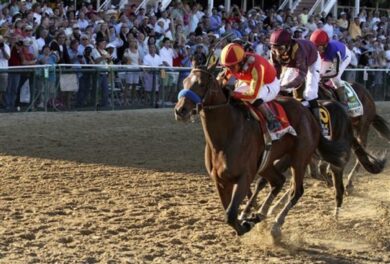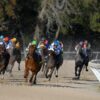Introduction:
In the world of sports, few events capture the imagination and adrenaline of spectators quite like horse racing. The thunderous gallop of powerful steeds, the vibrant jockeys adorned in colorful silks, and the electric atmosphere of the racecourse make horse racing a timeless and captivating spectacle. This article aims to delve into the thrilling world of horse racing, examining its rich history, the various types of races, the intricate partnership between horse and jockey, and the enduring allure that has made it a global phenomenon. Read more jepturf.
Historical Roots:
The roots of horse racing can be traced back to ancient civilizations where the speed and strength of horses were celebrated in various forms. In ancient Greece, chariot races were a testament to the agility and power of horses, while the Romans continued this tradition with grand equestrian events. However, it was in 17th-century England that horse racing evolved into a more organized and formalized sport.
The establishment of racetracks, the standardization of rules, and a growing interest in breeding horses for speed and stamina marked the birth of modern horse racing. As the British Empire expanded, so did the popularity of the sport, reaching new shores in North America and beyond. Today, horse racing stands as a global phenomenon, drawing enthusiasts from diverse backgrounds to witness the majesty of these magnificent animals in action.
Types of Horse Racing:
Horse racing comes in various forms, each with its own unique characteristics, challenges, and thrills. The three primary types of horse racing are flat racing, jump racing (steeplechase), and harness racing.
1. **Flat Racing:**
– *Characteristics:* Flat racing is the most common form, taking place on level tracks without obstacles.
– *Distances:* Races range from short sprints to longer distances, showcasing the speed, agility, and endurance of the horses.
– *Dynamic Action:* The pure speed and athleticism of the horses, guided by skilled jockeys, create a dynamic and thrilling spectacle.
2. **Jump Racing (Steeplechase):**
– *Characteristics:* Steeplechase races introduce obstacles such as fences and hurdles, adding an element of strategy and skill.
– *Distances:* Races cover varying distances, demanding both speed and jumping ability from the competing horses.
– *Thrilling Spectacle:* The sight of horses leaping over obstacles adds an extra layer of excitement, making steeplechase races a visually captivating experience.
3. **Harness Racing:**
– *Characteristics:* In harness racing, horses pull two-wheeled carts known as sulkies, with drivers (or jockeys) guiding them.
– *Distances:* The emphasis is on synchronized teamwork between the horse and driver over varying distances.
– *Unique Collaboration:* Harness racing showcases a different aspect of equine athleticism, emphasizing coordination and speed in tandem.
The Ballet of Horse and Jockey:
At the heart of horse racing lies the captivating partnership between horse and jockey, a relationship that goes beyond athleticism to encompass trust, understanding, and finely tuned skill.
1. **Training:**
– *Trainers as Mentors:* Trainers play a crucial role in shaping equine athletes, overseeing their diet, exercise, and overall well-being.
– *Jockeys as Partners:* Jockeys form unique bonds with their mounts, learning the nuances of each horse’s temperament and preferences.
2. **Starting Gate:**
– *Symbol of Anticipation:* The starting gate represents the commencement of the race, a moment filled with anticipation and excitement.
– *Explosive Start:* As the gates open, horses burst forth with explosive energy, setting the stage for the unfolding drama.
3. **Race Dynamics:**
– *Strategic Navigation:* Jockeys, adorned in vibrant silks that reflect their individual styles, navigate through the pack with skill and finesse.
– *Split-Second Decisions:* The race unfolds with split-second decisions, as jockeys position their mounts, responding to the ever-changing dynamics of the competition.
4. **Homestretch:**
– *Culmination of Drama:* The homestretch is the climax of the race, where horses unleash their final burst of speed, and the crowd’s roar reaches a crescendo.
– *Victory Defined:* The first horse to cross the finish line claims victory, marking the culmination of a spectacular performance.
The Atmosphere of Horse Racing:
Beyond the athletic prowess on display, horse racing is an immersive experience that engages the senses, drawing spectators into a world of excitement and elegance.
1. **Spectator Engagement:**
– *Fashion and Tradition:* Spectators, often dressed in their finest attire, contribute to the pageantry of the event, creating a sense of tradition and glamour.
– *Betting Excitement:* Betting on races adds an extra layer of excitement, as spectators become active participants, predicting outcomes and cheering for their chosen horses.
2. **Racecourses:**
– *Architectural Marvels:* Racecourses are architectural wonders, designed to accommodate both the functionality of the race and the comfort of spectators.
– *Paddocks and Pavilions:* The grandstands, paddocks, and exclusive pavilions contribute to the overall ambiance, creating an environment where the excitement is palpable.
Challenges and Triumphs:
While horse racing embodies elegance and excitement, it is not without challenges. Concerns about the welfare of racehorses, issues of overbreeding, and controversies surrounding drug use and injuries have prompted the industry to evolve and address these issues responsibly.
1. **Equine Welfare:**
– *Reforms and Responsibility:* The industry has implemented reforms to prioritize equine welfare, including enhanced veterinary care, stricter regulations, and a commitment to ethical horse management.
– *Balancing Tradition and Progress:* Striking a delicate balance between tradition and progress, the industry has embraced innovations to ensure the well-being of its equine athletes.
Conclusion:
Horse racing is more than a sport; it is a symphony of hooves, a ballet of speed and elegance that resonates through time and across cultures. From the historic racetracks that echo with the ghosts of past champions to the modern courses that host thrilling competitions, the allure of horse racing endures. As spectators witness the thundering hooves, the kaleidoscope of colors, and the electric atmosphere, they become part of a tradition that celebrates the indomitable spirit of competition and the timeless beauty of the horse. In the grand theaters of the racetracks, the symphony of horse racing continues to captivate hearts, ensuring its place as a cherished and timeless spectacle. Learn more capbleu3.

